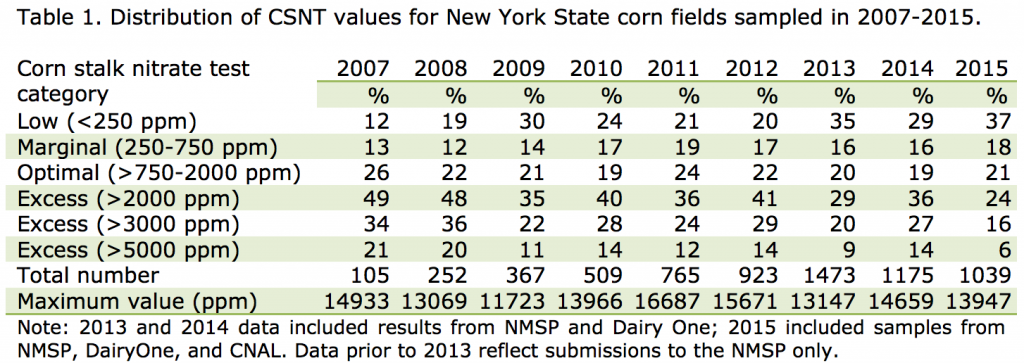Quirine Ketterings1, Karl Czymmek1,2, Sanjay Gami1, Mike Reuter3, and Mike Rutzke4
1Cornell University Nutrient Management Spear Program, 2PRODAIRY, 3Dairy One, and 4Cornell Nutrient Analysis Laboratory
The corn stalk nitrate test (CSNT) is an end-of-season evaluation tool for nitrogen (N) management for 2nd or higher year corn fields. The greatest benefit of this test is that it allows for evaluation and fine-tuning of N management for individual fields over time. Corn stalk nitrate test results >2000 ppm indicate there was significantly more N available during the growing season than the crop needed. It does, however, require multiple years of testing to gain experience with on-farm interpretation. In addition, within-field spatial variability can be considerable in New York, requiring (1) high density sampling (1 stalk per acre at a minimum) for accurate assessment of whole fields, or (2) targeted sampling based on yield zones, elevations, or soil management units.
The summary of CSNT results for the past nine years is shown in Table 1. Data prior to 2013 reflect submissions to the NMSP only. In the 2013 and 2015 growing season, the CSNT results from the NMSP, DairyOne, and CNAL were summarized to obtain a distribution of CSNT categories in New York State. A continued quality control program among the three laboratories showed excellent consistency in reported data. For 2015, this summary shows that about 24% of all tested fields were over the 2000 ppm range, while 16% were over 3000 ppm and 6% exceeded 5000 ppm. In contrast, 37% of the 2015 samples tested low in CSNT.
Crop history, manure history, other N inputs, soil type, and growing conditions all impact CSNT results, and crop management records that include these pieces of information can be used to evaluate CSNT results and determine where changes can be made. Weed pressure, disease pressure, lack of moisture in the root zone in drought years, lack of oxygen in the root zone due to excessive rain (anaerobic soil conditions), and other stress factors can impact the N status of the crop as well, so in some circumstances, additional N might not have been able to overcome the real reason for the low CSNTs (e.g. no amount of N fertilizer can make up for a drought). Work is ongoing within the NMSP to develop plant-based stress indicators that can help us identify when CSNT’s are low due to a lack of N versus where other stress factors existed.


